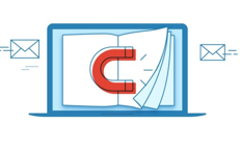For several years now, there’s been a debate raging about gated vs ungated content. This is more than simply a disagreement over strategy; it’s a conversation about the future of content marketing.
Once upon a time, content’s main quest was to build an audience by educating and entertaining people. But digital marketing evolved and so did the ROI expectations. Consequently, there’s been an entire generation of marketers raised on the Hubspot-style model of gated content and automated email drip campaigns.
Well, over 80% of marketers now say lead generation reigns supreme as their one true KPI. But has the pendulum swung too far? Does the current permutation of gated content sacrifice the customer relationship for the cheap thrill of better lead numbers?
In this post, we’ll dissect the current problems with gated content and examine if ungating your best assets might be the answer.
To Gate or Not to Gate

The gospel of gated content is based on relatively simple logic: if someone downloads a piece of gated content, they must be at least mildly interested in the topic it covers. After all, they did trade their email address for the information.
One good turn deserves another. If you follow up with that person through a series of automated (and ostensibly personalized) emails, you can convince them to buy your product. Do this at scale, and you’ll start seeing real ROI.
This has basically been the founding theory of lead generation for the last decade or two.
But over time cracks have appeared in the lead gen canon. Put simply, marketers have forgotten that the customer should come first. Or that customers are real people rather than data points to relentlessly email into submission.
Most landing page conversion numbers flounder in the single digits, because, as Contently’s Director of Marketing Joe Lazauskas puts it, people don’t want to “unleash unspeakable hell upon their inbox”.
In almost all cases, people are wary of giving businesses their information. Any retail person asking for an email at the counter can attest to this. Consumers worry because they don’t want to be flooded with email, which is exactly what many digital marketers have been doing as soon as someone downloads any PDF.
In his post about abolishing forms at Drift, Dave Gerhardt, former Director of Marketing at Drift, writes “marketing today has to be more about getting someone to fill out the next form and jump through the next hoop”.
Instead of building a list of people to endlessly email, Drift chose to focus on building stuff, i.e., content and free tools, that people actually wanted. It was definitely a risk, because their lead volume would go down. Still, the company trusted that if they treated their audience like they (the marketers from Drift) wanted to be treated, it would pay off.
Why Ungating Can Work

By narrowly focusing on lead numbers, we’ve forgotten that successful marketing builds relationships with our audience. Ungating content is a return to that principle.
At first blush, ungating your content may seem insane. But if you consider the benefits, saying goodbye to the gated PDFs might not be as radical as it seems.
You’ll get more attention and improve your SEO
Before you can get any leads, you need people to actually read your stuff and trust that you know what you’re talking about.
It’s going to be an uphill battle to get awareness to a landing page with a gated PDF—regardless of how good your copy is around the lead form. Content marketer Lauren Holiday’s most successful post came from an ebook she had published on her site. When the PDF was gated there, it generated two leads. That’s it: two leads. Once she ungated the piece, it exploded. The post drove almost 200,000 views, nearly 3,000 likes, and more than 100 comments. Then Inc. and Business Insider came calling to ask if they could republish it.
If you have a truly excellent piece of content, allowing everyone to read it could do much more for your brand than hiding the PDF behind a form. What’s more, publishing the entirety of your lead magnet on your site is exponentially better for SEO. It’s doubtful that Google will rank a landing page with 500 words of copy on it for any substantial keyword. But that megalith of a piece you wrote as a lead magnet stands a much better chance.
You’ll be able to measure content effectiveness
When you ungate your best content, you get an opportunity to make a better impression on readers. A portion of them will remember how good your stuff was and come back for more.
Too many marketers assume that once someone downloads a PDF, they’re fully committed to the cause. This simply isn’t true. There’s nothing worse than reading some great landing page copy and then downloading an absolute dud of a PDF. Letting your gated assets fly free affords you the ability to measure how engaging the material is to your readers (via Google Analytics, Hotjar, or FlippingBook). So you can see exactly how well your stuff performs.
By putting your best foot forward, you’re hooking readers with delivered value rather than anticipated value. The former makes a lasting positive impression, while the latter all too often ends in disappointment and a lowered opinion of the brand in question.
Your lead quality will increase
Isn’t everyone tired of the turf war between sales and marketing over lead quality? Marketing chucks anyone who downloads a mid funnel guide over the wall to sales, and sales never follows up because they know that person isn’t serious about buying. Once a quarter there’s a round of finger pointing and nothing changes.
Ungating your lead magnets gives people the autonomy to educate themselves and take the next step when it makes sense for them. With this approach, sales will readily accept opportunities that marketing passes along.
When Drift ungated their content, they actually saw a 15% increase in net new leads and a faster sales cycle.
In describing Contently’s decision to go ungated, Joe Lazauskas noticed that 80% of inbound opps were people who interacted with ungated assets. This is definitely surprising, but it showcases the power of well-crafted content. If you effectively educate your audience, they will remember. And when the time comes to choose a solution in your market, they’re more than likely to choose you.
Not everyone will see an increase in net new leads like Drift. However, it’s very possible that your lead quality will increase like it happened with Contently. When people call the shots—that is, when they decide it’s time to talk about buying—they’re much more likely to actually pull the trigger. And they’re even more likely to decide your organization is right for them if they experience your content in a frictionless way.
When Gating Makes Sense
Forms will probably never go away in digital marketing. Their utility is simply too great. Even Drift basically replaced forms with chatbots, so there was still a mechanism for collecting people’s information.
Here are a few times when gating content is necessary.
When you’re offering premium content
A lot of major media publications are moving to a freemium model of content: you get to read a certain number of articles a month and then you have to pay. This makes publishers less reliant on ad revenue and allows them to give readers a better user experience.
Even certain newsletters, like Trends and The Information, are behind a paywall, but the content is so good that it’s worth paying for—at least in theory.
This model of gated content can work, but the material really has to be stellar.
When you’re upgrading
Embedding CTAs inside content is a non-invasive way to give readers the option to take the next step if they’re ready. Thus, Soundstripe still keeps the storyboard template behind a form, but the CTA is embedded in a blog post about how to use such a template.
That next step might just be signing up for a newsletter if they enjoy the content enough, or it might be an invitation to start a free trial.
When it’s time for a demo
When someone wants to have a sales conversation, they’re probably willing to fill out a form. After all, how else will sales know who to call? This part of the customer journey is pretty straightforward, assuming that you’ve been able to persuade someone that your product is worthwhile.
Ungating your content isn’t as simple as snapping your fingers, saying a few magic words, and watching your lead quality go up. You probably need to have a paid strategy to retarget people with content once they visit your site.
But from a customer relationship standpoint—and an SEO and lead quality standpoint—ungated content has a ton of potential. The next time you’re working on a titanic piece of gated content, consider testing it as a blog post instead. The results might surprise you.
Author's bio:





